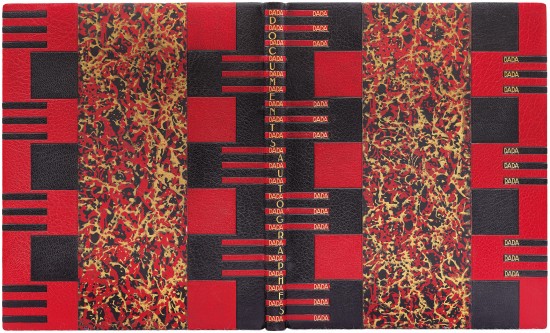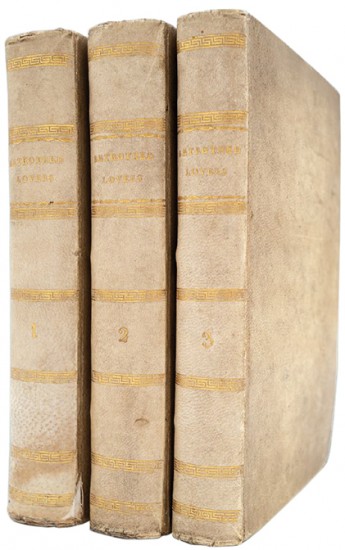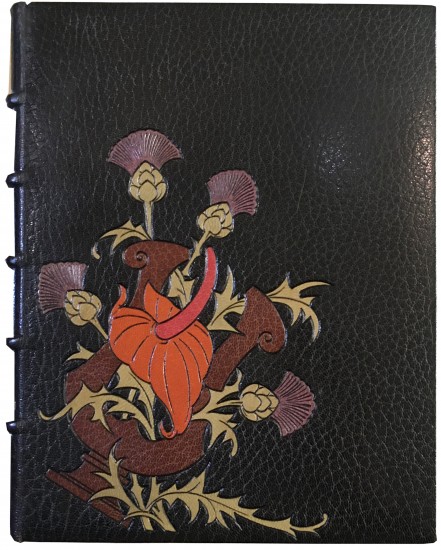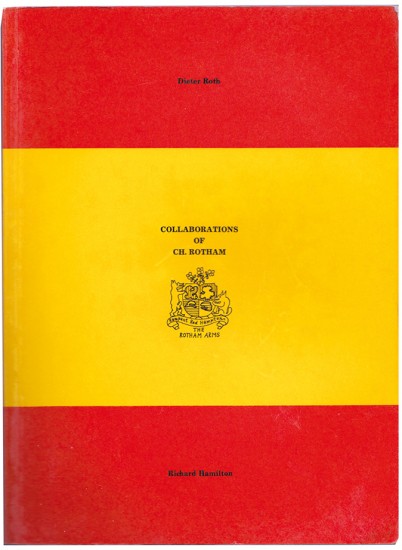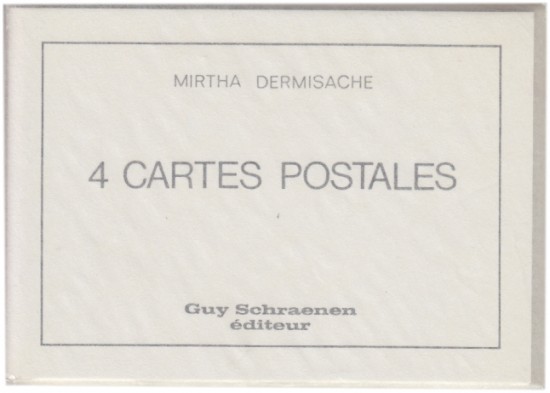Dada Documents Autographes. Dada and Surrealist Compositions
Tzara, Tristan
(Zürich / Paris). 1918. c.1918–c.1925
Sold
An exceptional collection of autograph manuscripts and drawings by Tristan Tzara spanning Zürich and Dada and Paris and Surrealism from the collection of René Gaffé, bound for him by Paul Bonet.
Spanning Tristan Tzara’s most fecund period of poetic endeavour, and providing a highly interesting not to say important aperçu into Tzara’s process of composition, this collection of original manuscripts is presented in an exceptional Art Deco binding by Paul Bonet dating to the very early 1930s. Bonet at the time worked extensively with André Breton and Paul Eluard, binding books and collections of manuscripts - as well as for Gaffé - and was creating very beautiful and stylised bindings in a marked Art Deco style. At a similar period, Bonet bound also for Gaffé, his set of ‘Littérature’, a series of manuscripts by Aragon, Breton’s ‘Clair de Terre’, Eluard’s ‘Au Défaut du Silence’ and others.
The prent series of manuscripts by Tristan Tzara, the Romanian (he was born Samuel Rosenstock) autodidact, enfant terrible, the ‘auto-barbare’ of Dada and theoretician of Surrealism, represent an exceptional trove of his creative output. The larger portion of the manuscripts feature work for ‘Cinéma Calendrier du Coeur Abstrait / Maisons’ (1920), ‘De Nos Oiseaux’ (1923) and ‘L’Antitête’ (1933) but also sections from larger works such as ‘la deuxième aventure céleste de monsieur Antipyrine’ (1920) and Tzara’s novel ‘Faites vos Jeux’ (c.1923) together with unpublished material. A postcard composed of original photographs sent to Eluard in 1921, bound in at the opening of the volume, appears to originate from Imst in Austria (Tzara was there with Arp, Breton, Ernst and Maja Kruschek) and the composition of ‘Dada au Grand Air’, the final flourish of Paris Dada. Perhaps the most important inclusion is a remarkable notebook of Tzara’s (75 x 135 mm) dating from his time in Zürich in 1918. This extraordinary little volume includes a number of drawings by Tzara as well as memoranda, lines of verse composed in isolation but later used in ‘Cinéma Calendrier du Coeur Abstrait / Maisons’, a list of contributors to Dada 3, noteworthy literary magazines, people of influence and so on. Tzara’s drawings, automatic cubo-futurist, caricature portraits and stylised abstractions decorate this small book of notes and give a further insight into the mind of the poet. It should also be noted that many of the other manuscripts in the present volume feature drawings and marginalia by Tzara.
Tzara’s compositions are almost exclusively in French - it must be borne in mind that this was not Tzara’s first language - and are for the most part written, with few corrections, on note paper in ink or pencil in Tzara’s legible hand. Tzara’s fluency of composition is remarkable and much of the material follows the final published versions, a measure more of Tzara’s assurance than of the present material being fair copy; even his poetic notes and thoughts scrawled in his notebook are faithful to those complete versions from ‘Cinéma Calendrier … ‘. The material for ‘Minuits pour Géants’, ‘Monsieur AA l’Antiphilosophe’ (both published in ‘L’Antitête’) or ‘De Nos Oiseaux’ displays an equal fluency and assurance and here it is really only those manuscripts that relate to Tzara’s autobiographical ‘Faites vos Jeux’ that display extensive alteration and excision. It seems clear that Tzara was a greedy appropriator of found paper and among the leaves in the present collection is a series of sheets of blue ‘MoUvEmEnT / DADA’ letterhead paper, sheets of ‘The Foreign Press Service’ paper as well as standard letter paper and the aforementioned notebook.
[see Tristan Tzara’s ‘Oeuvres Complètes’, Flammarion, 1975 - 1991; see ‘Bibliothèque de M. René Gaffé’ at Drouot, Paris, ’26 et 27 Avril 1956’, lot 237; see Bonet Carnets 204A (the binding listed among other examples executed for Gaffé, Eluard and Breton) & pl. 22; see 'MS Fr 340' at Harvard’s Houghton Library for a similar notebook].
Spanning Tristan Tzara’s most fecund period of poetic endeavour, and providing a highly interesting not to say important aperçu into Tzara’s process of composition, this collection of original manuscripts is presented in an exceptional Art Deco binding by Paul Bonet dating to the very early 1930s. Bonet at the time worked extensively with André Breton and Paul Eluard, binding books and collections of manuscripts - as well as for Gaffé - and was creating very beautiful and stylised bindings in a marked Art Deco style. At a similar period, Bonet bound also for Gaffé, his set of ‘Littérature’, a series of manuscripts by Aragon, Breton’s ‘Clair de Terre’, Eluard’s ‘Au Défaut du Silence’ and others.
The prent series of manuscripts by Tristan Tzara, the Romanian (he was born Samuel Rosenstock) autodidact, enfant terrible, the ‘auto-barbare’ of Dada and theoretician of Surrealism, represent an exceptional trove of his creative output. The larger portion of the manuscripts feature work for ‘Cinéma Calendrier du Coeur Abstrait / Maisons’ (1920), ‘De Nos Oiseaux’ (1923) and ‘L’Antitête’ (1933) but also sections from larger works such as ‘la deuxième aventure céleste de monsieur Antipyrine’ (1920) and Tzara’s novel ‘Faites vos Jeux’ (c.1923) together with unpublished material. A postcard composed of original photographs sent to Eluard in 1921, bound in at the opening of the volume, appears to originate from Imst in Austria (Tzara was there with Arp, Breton, Ernst and Maja Kruschek) and the composition of ‘Dada au Grand Air’, the final flourish of Paris Dada. Perhaps the most important inclusion is a remarkable notebook of Tzara’s (75 x 135 mm) dating from his time in Zürich in 1918. This extraordinary little volume includes a number of drawings by Tzara as well as memoranda, lines of verse composed in isolation but later used in ‘Cinéma Calendrier du Coeur Abstrait / Maisons’, a list of contributors to Dada 3, noteworthy literary magazines, people of influence and so on. Tzara’s drawings, automatic cubo-futurist, caricature portraits and stylised abstractions decorate this small book of notes and give a further insight into the mind of the poet. It should also be noted that many of the other manuscripts in the present volume feature drawings and marginalia by Tzara.
Tzara’s compositions are almost exclusively in French - it must be borne in mind that this was not Tzara’s first language - and are for the most part written, with few corrections, on note paper in ink or pencil in Tzara’s legible hand. Tzara’s fluency of composition is remarkable and much of the material follows the final published versions, a measure more of Tzara’s assurance than of the present material being fair copy; even his poetic notes and thoughts scrawled in his notebook are faithful to those complete versions from ‘Cinéma Calendrier … ‘. The material for ‘Minuits pour Géants’, ‘Monsieur AA l’Antiphilosophe’ (both published in ‘L’Antitête’) or ‘De Nos Oiseaux’ displays an equal fluency and assurance and here it is really only those manuscripts that relate to Tzara’s autobiographical ‘Faites vos Jeux’ that display extensive alteration and excision. It seems clear that Tzara was a greedy appropriator of found paper and among the leaves in the present collection is a series of sheets of blue ‘MoUvEmEnT / DADA’ letterhead paper, sheets of ‘The Foreign Press Service’ paper as well as standard letter paper and the aforementioned notebook.
[see Tristan Tzara’s ‘Oeuvres Complètes’, Flammarion, 1975 - 1991; see ‘Bibliothèque de M. René Gaffé’ at Drouot, Paris, ’26 et 27 Avril 1956’, lot 237; see Bonet Carnets 204A (the binding listed among other examples executed for Gaffé, Eluard and Breton) & pl. 22; see 'MS Fr 340' at Harvard’s Houghton Library for a similar notebook].
[6 bifolia + 30 leaves = 42 leaves + notebook of 40 leaves]. 4to. (278 x 230 mm). Original blue envelope addressed to René Gaffé and sent by Paul Eluard as front wrapper (the rear of the envelope bound in as the rear wrapper), postcard with two original monochrome photographs and manuscript text in a variety of inks and pencil on a variety of paper stock by Tristan Tzara throughout, numerous alterations and excisions and marginal drawings throughout together with an original notebook by Tzara (see below); the leaves mounted on tabs throughout. Black morocco with red morocco inlays over gilt, scarlet and black marbled paper by Paul Bonet, front board with 'DADA' tooled in gilt to 12 inlaid sections of red and 9 inlaid sections of black morocco to form a mosaic, rear board with matching decor without title, smooth spine with alternating red and black morocco inlays, 'DADA' in gilt to 21 red inlaid sections, 'DOCUMENTS AUTOGRAPHES' in gilt to alternate black inlays, gilt, scarlet and black marbled endpapers, t.e.g., black morocco-edged suede-lined marbled board slipcase.
#47385
